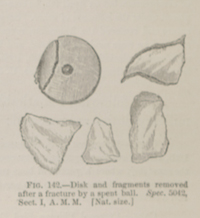Title: Wiest, Philip A.
Source text: Surgeon General Joseph K. Barnes, United States Army, The Medical and Surgical History of the War of the Rebellion. (1861–65.), Part 1, Volume 2 (Washington, D.C.: Government Printing Office, 1870), 283.
Civil War Washington ID: med.d1e16959
TEI/XML: med.d1e16959.xml
CASE.—Private Philip A. W——, Co. A, 50th Pennsylvania Volunteers, aged 21 years, was wounded at Petersburg, Virginia, July 30th, 1864, by a conoidal ball, which imbedded itself in the integument and muscles of the left side of the head, fracturing and depressing a portion of the skull a little above and to the left of the occipital protuberance. The missile was removed by the hand. He was somewhat stunned by the blow, but arose and walked to the hospital of the 3d division, Ninth Corps, when he became unconscious and remained so for eighteen hours. On the following day he returned to his regiment, not knowing that his injury was severe, but he was returned to the hospital, where he remained for one week. He suffered severe headache and was unable to see or hear well. On August 11th, he was admitted into the Soldier's Rest, branch of 1st division hospital, Alexandria, Virginia. He seemed to improve for two days, then grew worse, complaining of pain in the frontal region of the head, especially over the left orbital ridge. On the 16th, he became unconscious for about two hours. It being deemed advisable to remove the depressed portion of bone, ether was administered, and Assistant Surgeon Theodore Artaud, U. S. V., made a crucial incision, half an inch in length, directly over the injury, and dissected up the occipito-frontalis muscle, revealing an indentation, half an inch in length, making a very regular cup-shaped depression, three-fourths of an inch in diameter, with a slight fissure around its edge and an irregular one across its centre. The trephine was applied so as to partially cover one side of the depression, and a portion of the skull was removed. The depressed bone was then removed by the elevator, exposing the dura mater, which was found to be healthy. A circular tent was applied over the exposed portion of brain, the wound dressed with cold water dressings, and morphia given to quiet the patient. The following day he was able to sit up, and by the 20th could walk about. On the 26th, he was seized with violent signs of compression, but was soon relieved by sinapisms to the neck, abdomen, and extremities. Croton oil was given, and afterward the wound, which had nearly healed, was enlarged and kept open with tents for three days, with but slight inconvenience to the patient. He had slight headache on the morning of September 1st, but his general condition was good and improving. He ate and slept well, and by the 22d, the wound had entirely closed. He occasionally complained of slight headache, and was, to all appearances, cured. He was transferred to Slough Barracks, branch of 3d division hospital, on October 5th, remaining until May 10th, 1865, when he was sent to the Augur Hospital, Alexandria, and thence, on the 20th, transferred to the McClellan Hospital, Philadelphia. He was discharged from the service on July 6th, 1865. A communication from the Commissioner of Pensions, dated July, 1868, states that Wiest is a pensioner at $8 per month, his disability being rated total and temporary. The specimen was contributed, with an history, by the operator, Assistant Surgeon Theodore Artaud, U. S. V.
